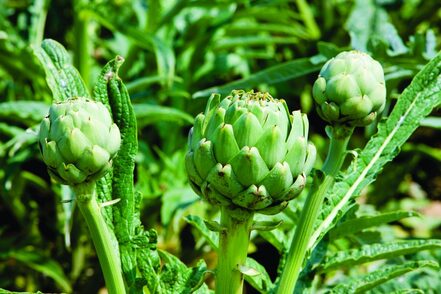 Fall has its unique challenges when it comes to pest control, and now is the time to get your Tool Box prepared for the fall so you can deter pests rather than waiting for an issue to emerge later. Seriously, if you are waiting to have a pest problem, you will be too late. We recommend a basic foliar spray program every 10 to 14 days. In your backpack sprayer combine the following: Fish & Seaweed - 2oz/gal Molasses - 1oz/gal This will be your basic spray program to maintain healthy growth. The following insect controls can be added to the mix to deter pests. Notice: to deter pests. When we get comments that “organic doesn’t work” it’s usually due to the fact that you have waited to treat pests too late. Once you have an infestation, you are late into the game. To have a successful organic program, you need to deter pest problems, encourage beneficials and prevent infestations to begin with. We rotate between these three recipes to avoid pest building tolerance to our remedies. SPRAY MIX #1 Basic spray to deter pests and increase yield, rotate with SPRAY MIX #2 Fish & Seaweed - 2oz/gal Molasses - 1oz/gal Neem Oil – natural fungicide and systemic insecticide Garlic Oil – pest deterrent and emulsifier SPRAY MIX #2 Basic spray to deter pests and increase yield, rotate with SPRAY MIX #1 Fish & Seaweed - 2oz/gal Molasses - 1oz/gal Spinosad – Biological control to deter most insects SPRAY MIX #3 (WORMS/CATERPILLARS) Typically needed in Spring and Fall for brassicas, lettuce and leafy greens, also tomato horn worm. Spray when needed. Fish & Seaweed - 2oz/gal Molasses - 1oz/gal Bt Concentrate – Biological treatment for all caterpillars and worms These all need to be applied with a backpack sprayer. Here are our favorites: Pump Backpack Sprayer Battery Powered Backpack Sprayer We encourage you to stock up your Pest Control Tool Box now as we are heading into the fall growing season. Don’t let annoying insect damage ruin the quality of your fall garden. FOR MORE INFORMATION AND COACHING, JOIN US ON PATREON
1 Comment
August is the month to clean beds and prepare for fall planting. With the extreme temperatures and lack of rain in Texas and the deep South, most gardens have completed their productivity, with the exception of peppers, okra, eggplant and late plantings of squash (thus the creation of ratatouille). Now is the time to prepare for the upcoming season.
We will be discussing:
TO READ THE ENTIRE ARTICLE AND FOR MORE GROW TIPS GO HERE>>>  First a little history… Artichokes have long captured the palates and imaginations of food enthusiasts worldwide. Their unique appearance, delicate flavor, and versatility in culinary applications make them a sought-after vegetable in various dishes. Beyond their gastronomic appeal, artichokes boast a fascinating history that traces back thousands of years. The artichoke's history can be traced back to the Mediterranean region, where its wild ancestor, the cardoon, flourished in the warm climates of Southern Europe and North Africa. Ancient Greeks and Romans were among the first civilizations to appreciate the artichoke's culinary and medicinal qualities. The Greeks even revered the plant for its purported aphrodisiac properties and considered it a symbol of fertility and immortality. During the Middle Ages, the artichoke took root in various European regions, and its popularity began to grow. The Moors in Spain are credited with further cultivating and introducing new varieties of artichokes. By the time of the Renaissance, the artichoke had firmly established itself as a prized vegetable in the culinary circles of Italy and France. The artichoke's journey from Europe to other parts of the world is intertwined with exploration and trade. In the 16th century, Spanish and Portuguese explorers brought the artichoke to the Americas, where it found fertile ground in the mild coastal climates of California. Over time, Spanish colonies and trading routes facilitated the distribution of artichoke plants to Latin American countries, where they also found favorable growing conditions. Once in the New World, the artichoke continued to gain culinary significance. In the 19th and early 20th centuries, Italian immigrants who settled in the United States brought their love for artichokes with them. The city of Castroville, California, eventually became known as the "Artichoke Center of the World," owing to its vast artichoke cultivation and annual artichoke festival, celebrating this unique vegetable. As culinary techniques evolved, chefs and home cooks embraced the artichoke's versatility in various cuisines. From simple preparations like steaming and grilling to elaborate stuffing and incorporating it into pasta dishes, artichokes have found their way into numerous recipes. Additionally, the heart of the artichoke, prized for its tender texture and delicate flavor, has become a popular ingredient in salads, dips, and spreads. Beyond their delicious taste, artichokes boast a host of health benefits. Rich in dietary fiber, vitamins, and minerals, they promote digestive health, aid in weight management, and support heart health. Artichokes are also known for their antioxidant properties and potential to lower cholesterol levels. The artichoke's journey through history has been nothing short of remarkable. From its humble beginnings in the Mediterranean to its widespread cultivation across the globe, this thorny delicacy has firmly secured its place in the world of culinary delights. Whether steamed, grilled, or blended into a sumptuous dip, artichokes continue to captivate food enthusiasts, and their rich history adds a layer of fascination to every dish they grace. Globe Artichokes are a rewarding crop and add major interest to the garden. The fleshy bases of the outer bracts, the inner bracts, and the heart are edible, if allowed to fully bloom, they also make a great cut flower and can yield major economic value for the small farmer. A single plant can produce generous flowers, as many as 40 to 50 per plant! FOR GROWING INSTRUCTIONS, JOIN US ON PATREON >> |
AuthorBrad and Jenny have been professional growers for over 30 years. They raised their family homesteading in Texas and are considered "pioneers in the local food movement". They started from scratch and created the first and largest Community Supported Agriculture (CSA) farm serving Houston, TX. MORE ABOUT US >> Archives
September 2023
Categories |
